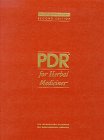PDR for Herbal Medicines
Publisher: Medical Economics Company OncoLink Rating: |
It has been shown approximately 40% of cancer patients are using some form of unconventional medical therapy (UMT). Herbal medicines represent a large fraction of UMT used by cancer patients. Unfortunately, the availability of sound scientific information for most of these treatments is limited. Also, because health care providers have not had formal education about herbal therapies, many do not know where to turn for reliable information.
The PDR for Herbal Medicines helps to fill this void. Medical professionals can feel confident that they are receiving information from a reliable, trusted resource. Healthcare providers will note this resource is much smaller than the PDR for prescription medications. This is due to the fact that much less scientific information is available about herbal medications than prescription medications. However, whenever scientific information is available, the herbal PDR presents the information in a readable and quickly digestible format. The resource is well organized so it can be used in a busy clinical situation. This resource should be available in every physician's office and nursing station.
The information on specific herbal medicines can be located quickly because both the scientific and common names are included in the index. There is also an index organized by specific indications, enabling the reader to quickly review the botanical alternatives for a particular diagnosis. There is even a side effects index, which includes an alphabetical list of every side effect cited in the herbal monographs. Full-color photographs of 380 common medicinal herbs are included and arranged alphabetically by scientific names.
The reference contains information on over 600 herbal therapies. Much of the herbal monographs section is based upon the work conducted by the acclaimed German Federal Health Authority's Commission E. This is the governmental body is recognized as having done the most authoritative evaluation of herbal medicines. For those herbs not evaluated by this commission, noted botanist Dr. Joerg Gruenwald has directed a literature review to provide a comprehensive evaluation of an additional 300 herbals. Each monograph contains the scientific and common name, detailed botanical description of the herb, active compounds and clinical effects of the herb, indications and uses, contraindications, side effects, overdose effects, recommended dose and routes of administration, and a bibliography of the scientific literature.
This resource is an indispensable guide to herbal medications. This is the best herbal guide currently available. It contains accurate, reliable information for the health care professional. Every physician, nurse, and medical student should have a copy of this comprehensive resource. OncoLink considers the PDR to Herbal Medicines the definitive guide to herbal therapies.


